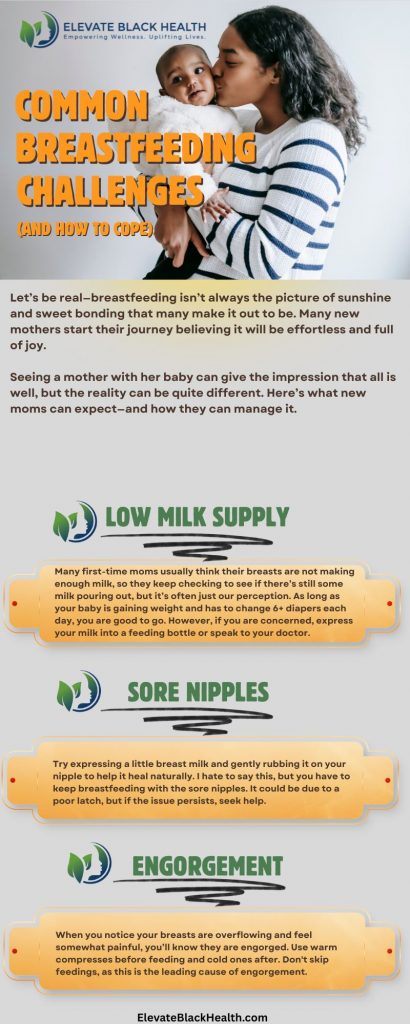When I had my first baby in 2021, I started my breastfeeding journey with a mix of excitement, questions, and fear. Just two days in, I found myself wondering why something so natural felt so confusing and overwhelming. According to UNICEF, many first-time Black mothers share this experience.
Breastfeeding offers babies ideal nutrition, and antibodies, a beautiful opportunity for bonding. Still many mothers, especially in the Black community, opt out. Findings from a CDC report show that only 75% of Black mothers initiate breastfeeding when compared to white infants at 84%. Also, only 57% of Black mothers extend breastfeeding when compared to 77% Whites. The reason for this, according to The Global Health Network, is that many Black women do not get access to the same support and quality information as white counterparts.
Every August, we celebrate National Breastfeeding Awareness Month. This year is a perfect time to center the Black community, highlighting what to expect, how to overcome challenges, and importantly, why you are more capable than you think.
The First Few Days
In the first few days after you give birth, your body will produce nutrient-rich milk called colostrum. It is thick, yellow, and packed with antibodies. Your breasts may make a lot of milk, so don’t worry, that is what your newborn needs. Also, you’ll need to get a lot of positive support before and after giving birth so it’s important to find someone (partner, mother, aunt, or friend) who can be with you during this period. Positive support will help with frustration and post-partum depression.
What to Expect
- Your baby typically wants to feed between 8 and 12 times a day
- Nursing your baby can last between 20 and 45 minutes
- Your breasts may feel tender or sore
Helpful Tip
Practice skin-to-skin contact immediately after giving birth. This helps your heartbeat, breathing, temperature, and latching success.
Mastering Latching
Looking back on my first experience, I can tell you that breastfeeding is a learning experience, not just for you but for your baby. Latching, which describes how your baby attaches to your breast while breastfeeding, can be very tricky. Learning how to latch a one-day-old baby and teaching your baby how to latch properly is not as simple as ABC, compounded with all the pains of childbirth.
According to Stanford Medicine, despite all your efforts to get your baby to latch correctly, you may not succeed due to tongue tie, heart disease, jaundice, prematurity, a mother’s medicine, and infections. This becomes an issue because if a baby cannot properly latch, it will result in poor weight gain and reduce the milk the breast produces.
If properly done, latching leads to a smooth breastfeeding experience, but it will take time for you and your baby to get the hang of it. Mine took me almost two weeks for my first baby, but far less for the second.
Here are signs of a good latching:
- Baby’s mouth covers both the nipple and part of the areola
- You don’t feel pain, but a tugging sensation
- You can hear swallowing
Note: If latching causes discomfort or your baby appears frustrated, consult a doctor immediately.

Pumping, Bottles, and Feeding in Public
There is no fixed method of breastfeeding. Some mothers exclusively nurse, others pump and bottle-feed, and some combine feeding with formula. I have tried all of them, and I can tell you that they are all valid. Just do what works for you.
If you choose to pump:
- Have a schedule, especially if returning to work
- Invest in a quality pump
- Store milk safely (ensure you read up on guidelines for that)
Feeding in Public
All 50 States in the US have made it legal for women to breastfeed in public, and this practice is legal in many parts of the world.
Now all you need to do is find something that makes you comfortable. It could be a nursing cover, a quiet corner, or neither, as long as you are comfortable.
Every Drop Counts, Every Effort Matters
Are you doing it “right”? Mama, if you are trying, learning, and showing up—then yes, you are. This August we celebrate your strength. Whether you are nursing through the night, washing pump parts, or trying to figure it out, your love and dedication are nourishing your baby in more ways than you can know.
You’ve got this, Mama.
Want to dive deeper into this topic? Check these additional resources:
- 5 Common Breastfeeding Problems. https://www.unicef.org/parenting/food-nutrition/5-common-breastfeeding-problems
- About Breastfeeding. https://www.cdc.gov/breastfeeding/php/about/index.html
- 9 Sociological and Cultural Influences upon Breastfeeding. https://tghncollections.pubpub.org/pub/9-sociological-and-cultural-influences-upon-breastfeeding/release/2
- Problems with Latching On or Sucking. https://www.stanfordchildrens.org/en/topic/default?id=difficulty-with-latching-on-or-sucking-90-P02650
- Tongue-tie (ankyloglossia). https://www.mayoclinic.org/diseases-conditions/tongue-tie/symptoms-causes/syc-20378452
- Difficulty with Latching On or Sucking. https://www.hopkinsmedicine.org/health/wellness-and-prevention/difficulty-with-latching-on-or-sucking
- Skin-to-skin Contact. https://www.unicef.org.uk/babyfriendly/baby-friendly-resources/implementing-standards-resources/skin-to-skin-contact/
- Motherhood and Finding Parenting Support: A Guide for Black Women. https://www.elevateblackhealth.com/motherhood-and-finding-parenting-support-a-guide-for-black-women/
- Breastfeeding in Public Is Now Legal in All 50 US States. https://www.globalcitizen.org/en/content/public-breastfeeding-is-now-legal-in-all-50-states/
- Empowering Black Mothers to Overcome Breastfeeding Stigma. https://www.elevateblackhealth.com/empowering-black-mothers-to-overcome-breastfeeding-stigma/








